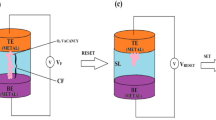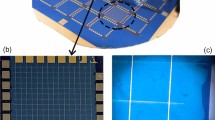Abstract
In this paper, the HfOx-based resistive random access memory (RRAM) devices with sub-100 nm pyramid-type electrodes were fabricated. With the help of tip-enhanced electric field around the pyramid-type electrodes, it was experimentally demonstrated that the novel devices have better cycle-to-cycle variation control, lower forming/set voltage (1.97/0.7 V) and faster switching speed (⩽ 30 ns under 0.9 V pulse) as well as better endurance reliability than conventional flat electrode resistive memory devices. In addition, the novel RRAM is experimentally demonstrated with independence of electrode number for the first time to present great potential in scaling down. This novel structure metal-oxide based RRAM will be suitable for the future low-power non-volatile memory application.
Similar content being viewed by others
References
Lee H Y, Chen Y S, Chen P S, et al. Low-power and nanosecond switching in robust hafnium oxide resistive memory with a thin Ti cap. IEEE Electron Dev Lett, 2010, 31: 44–46
Cui X L, Zhang Q, Cui X X, et al. Testing of 1TnR RRAM array with sneak path technique. Sci China Inf Sci, 2017, 60: 029402
Zhao X L, Wang R, Xiao X H, et al. Flexible cation-based threshold selector for resistive switching memory integration. Sci China Inf Sci, 2018, 61: 060413
Wong H S P, Lee H Y, Yu S, et al. Metal-oxide RRAM. Proc IEEE, 2012, 100: 1951–1970
Yang Y C, Gao P, Gaba S, et al. Observation of conducting filament growth in nanoscale resistive memories. Nat Commun, 2012, 3: 732
Yang Y C, Zhang X X, Qin L, et al. Probing nanoscale oxygen ion motion in memristive systems. Nat Commun, 2017, 8: 15173
Wang Y, Lv Z Y, Liao Q F, et al. Synergies of electrochemical metallization and valance change in all-inorganic perovskite quantum dots for resistive switching. Adv Mater, 2018, 30: 1800327
Cooper D, Baeumer C, Bernier N, et al. Anomalous resistance hysteresis in oxide ReRAM: oxygen evolution and reincorporation revealed by in situ TEM. Adv Mater, 2017, 29: 1700212
Guan X M, Yu S M, Wong H S P. On the switching parameter variation of metal-oxide RRAM-Part I: physical modeling and simulation methodology. IEEE Trans Electron Dev, 2012, 59: 1172–1182
Gao B B, Zhang H W, Yu S M, et al. Oxide-based RRAM: uniformity improvement using a new material-oriented methodology. In: Proceedings of the Symposium on VLSI Technology, Honolulu, 2009
Liu Q, Long S B, Wang W, et al. Improvement of resistive switching properties in ZrO2-Based ReRAM with implanted Ti ions. IEEE Electron Dev Lett, 2009, 30: 1335–1337
Wang Z W, Kang J, Fang Y C, et al. Localized metal doping effect on switching behaviors of TaOx-based RRAM device. In: Proceedings of the 16th Non-Volatile Memory Technology Symposium, Pittsburgh, 2016
Bai Y, Wu H Q, Zhang Y, et al. Low power W: AlOx/WOx bilayer resistive switching structure based on conductive filament formation and rupture mechanism. Appl Phys Lett, 2013, 102: 173503
Bousoulas P, Michelakaki I, Skotadis E, et al. Low-power forming free TiO2−x/HfO2−y/TiO2−x-trilayer RRAM devices exhibiting synaptic property characteristics. IEEE Trans Electron Dev, 2017, 64: 3151–3158
Huang Y C, Tsai W L, Chou C H, et al. High-performance programmable metallization cell memory with the pyramid-structured electrode. IEEE Electron Dev Lett, 2013, 34: 1244–1246
Shin K Y, Kim Y, Antolinez F V, et al. Controllable formation of nanofilaments in resistive memories via tip-enhanced electric fields. Adv Electron Mater, 2016, 2: 1600233
Lanza M, Wong H S P, Pop E, et al. Recommended methods to study resistive switching devices. Adv Electron Mater, 2019, 5: 1800143
Chen Y Y, Goux L, Clima S, et al. Endurance/retention trade-off on HfO2/Metal cap 1T1R bipolar RRAM. IEEE Trans Electron Dev, 2013, 60: 1114–1121
Padovani A, Larcher L, Pirrotta O, et al. Microscopic modeling of HfOx RRAM operations: from forming to switching. IEEE Trans Electron Dev, 2015, 62: 1998–2006
Mott N F, Davis E A. Electronic Processes in Non-crystalline Materials. Oxford: Oxford University Press, 1979
Jegert G, Kersch A, Weinreich W, et al. Modeling of leakage currents in high-k dielectrics: three-dimensional approach via kinetic Monte Carlo. Appl Phys Lett, 2010, 96: 062113
Yu S M, Guan X M, Wong H S P. Conduction mechanism of TiN/HfOx/Pt resistive switching memory: a trap-assisted-tunneling model. Appl Phys Lett, 2011, 99: 063507
Long S B, Cagli C, Ielmini D, et al. Reset statistics of NiO-based resistive switching memories. IEEE Electron Dev Lett, 2011, 32: 1570–1572
Govoreanu B, Clima S, Radu I P, et al. Complementary role of field and temperature in triggering ON/OFF switching mechanisms in Hf/HfO2 resistive RAM cells. IEEE Trans Electron Dev, 2013, 60: 2471–2478
Niu J B, Zhang M Y, Li Y, et al. Highly scalable resistive switching memory in metal nanowire crossbar arrays fabricated by electron beam lithography. J Vacuum Sci Tech B, 2016, 34: 02G105
Govoreanu B, Kar G S, Chen Y Y, et al. 10×10 nm2 Hf/HfOx crossbar resistive RAM with excellent performance, reliability and low-energy operation. In: Proceedings of IEDM Technology, Washington, 2011
Acknowledgements
This work was supported in part by National Key Research and Development Plan (Grant No. 2016YFA0200504), National Science and Technology Major Project (Grant No. 2017ZX02315001-004), National Natural Science Foundation of China (Grant No. 61421005), and 111 Project (Grant No. B18001).
Author information
Authors and Affiliations
Corresponding author
Rights and permissions
About this article
Cite this article
Li, X., Zhang, B., Wang, B. et al. Low power and high uniformity of HfOx-based RRAM via tip-enhanced electric fields. Sci. China Inf. Sci. 62, 202401 (2019). https://doi.org/10.1007/s11432-019-9910-x
Received:
Revised:
Accepted:
Published:
DOI: https://doi.org/10.1007/s11432-019-9910-x




